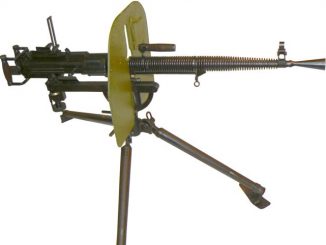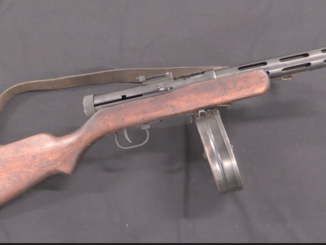Degtyarev’s PPD-40 was the first submachine gun adopted in a large scale by the Soviet Union. Its development began in 1929 with a locked breech gun modeled after Degtyarev’s DP light machine gun, but evolved into a much simpler blowback system. It was accepted as the best performing gun of 14 different submissions in Soviet trials of 1931/2, and first entered production in 1934. In this form, it used a 25 round curved stick magazine, and was chambered for the 7.62x25mm cartridge. In 1938 Degtyarev made a number of changes, most importantly developing a drum magazine based on the Finnish Suomi m31 drum. The PPD-38 drum had a short section of feed tower to allow the gun to use either drums or stick magazines, and this was dropped with the final iteration in 1940 when the gun was agains changed, this time to accept only 71 round drum magazines of the m31 type.
The PPD-40 finally entered serious production in 1940, with just over 81,000 made. This production would continue into early 1941 with another roughly 6,000 made before it was replaced by the faster to produce PPSh-41 submachine gun. The PPD-40 was a relatively heavy SMG at 12 pounds (5.45 kg) unloaded, and with a rate of fire of approximately 900 rounds per minute. This particular example was captured and used by the Finnish military, and appears to have a PPD38 bolt in it.




I wonder if Degtyarov and Shpagin teamed up later. But the drum magazine seems to be a problem for weight and lack of interchangeability between guns, right?
This may be good question for Daweo to address. My impression based on little I know of gun design and development in former CCCP is that the individuals and teams were typically in fierce competition, something not exactly inherent with collectivist way of conduct.
Both of them started designing of fire-arm under Fyodorov (designer of Fyodorov Avtomat). Also Degtyaryov was able to admit that his creation was inferior to someone else, so despite having impression on Stalin, he do not use that for personal gain. Anecdotal story is that Degtyaryov was once asked by Stalin: Whose machine gun is superior? Yours or comrade Goryunov? and reply was comrade Goryunov and that second was put into production. Also you might known DShK machine gun, also known as DShK-38, however story started much earlier than 1938 – in early 1930s.
Machine gun, yet known as DK fired 12,7×108 but it was magazine-feed. Shpagin designed belt-fed (and also some other improvements for better reliability) which resulted in DShK. Early story of Degtyaryov 12,7-mm machine gun is described here (with focus aircraft application point-of-view): http://www.airwar.ru/weapon/guns/dak32.html
BTW: Degtyaryov was creating universal machine guns however in other understanding that modern – all sizes shares commonality, this was big advantage from point of training. For example if you know as DP works, you should understand how DShK works easier than totally different design.
Addendum: Evidence of being liked by Stalin is fact that Degtyaryov got various badges, including but not limited to:
Hero of Socialist Labour (Герой Социалистического Труда) and he was second recipient of that title.
-State Stalin Prize, commonly known as Stalin Prize (Сталинская премия) [4 times]
-Order of Lenin (Орден Ленина) – highest award, which can be scored out-side combat
Ah, here I missed the opportunity to fill in…. they did work together on famous “Doushka” https://en.wikipedia.org/wiki/DShK
Interestingly, Degtyaryov layout was recently used in self-loading rifle
http://modernfirearms.net/sniper/sniper-rifles/usa/ulfberht-e.html
Degtyaryov had also worked in 1930s, trying to make automatic rifle:
http://commi.narod.ru/txt/markev/527.htm
but failed to provide enough reliability
Again, great show and it is appreciated. This gun had become kind of obscure since PPSh-41 took over image of Soviet SMGs. And yes the title is “pulemyot-pistolet degtaryeva” meaning literally “bullet throwing pistol of Degtaryev”. Sometimes I saw name Degtaryov, but I lean on former one more.
One detail I have not seen before and which puzzles me a bit is “lip” extending forward from stripping lug, seen as around 9:40 of video. Was it supposed o work in conjunction with (btw. cleverly designed) firing pin actuation?
Some explanation:
Transliterating might vary, proper orthography is Дегтярёв, however in Russian that dots in ё are optional, so it is legal to also write Дегтярев.
ё in most cases denotes йo sound (yo in English, I suspect), so in fact using -ryov is more correct that -ryev if you want to have similar sound.
Query in English wikipedia exist for that letter, look for it for more data:
https://en.wikipedia.org/wiki/Yo_(Cyrillic)
“pulemyot-pistolet degtaryeva”
Not that but rather “pistolet-pulemyout”, or yielding to manual (for 34 version):
P. P. D.
(Pistolet-pulemyout sistema Degtaryova obr. 1934 g.)
“meaning literally”
To be exact, it would be rather bullet-thrower, like in миномёт = mine-thrower, i.e. mortar cf. Minenwerfer) or огнемёт = flamethrower, cf. Flammenwerfer
“Its development began in 1929 with a locked breech gun modeled after Degtyarev’s DP light machine gun, but evolved into a much simpler blowback system.”
No, it has traits of DP machine gun, but it was neither locked breech neither blow-back – but delayed blow-back design. It has that Degtyarov’s flaps/braces/whatever-its-name-in-English-is, but not gas system, thus it worked more-or-less like, much later, H&K MP5, with that elements instead of rollers.
Photo:
https://armyman.info/avtomaty/3388-degtyaryov-obr.-1929-toz.html
“PPD-38 drum had a short section of feed tower to allow the gun to use either drums or stick magazines”
According to Degtyarov’s memoirs (Моя жизнь, 1950) this magazine was made in great hurry, in time when battles with white-finns, he promised Stalin to make that magazine in 7 days. Degtyarov in his memoirs, do not skip help of engineers.
“The PPD-40 finally entered serious production in 1940, with just over 81,000 made. This production would continue into early 1941 with another roughly 6,000 made before it was replaced by the faster to produce PPSh-41 submachine gun.”
Locally true, globally false.
In Tula, PPSh replaced PPD.
In Leningrad (завод им. С. П. Воскова and since December 1941 завод им. А. А. Кулакова), it was produced until December 1942. In 1941-1942 42870 examples were made. They are dubbed «блокадники» or described as «блокадный выпуск», both name refers to Siege of Leningrad (Блокада Ленинграда in Russian). Many has some differences from “normal” PPD: simplified sights, simpler safety and other minors alterations.
https://ru.wikipedia.org/wiki/ППД-34/40
Despite that PPSh replaced PPD, that second was sometime used as pattern by partisan for making own weapon, like:
https://en.wikipedia.org/wiki/Choroszmanów_submachine_gun
(BTW: that query title has error, as Polish language is inflencted, see talk section for more data)
Found some interesting details in that Russian wikipedia article (via Google’s finest translation):
Discussing changes from the PPD-38 to the PPD-40: “the bobbin fixed in the cup of the bolt appeared instead of a separate drummer on the axis … However, practice has shown that the simplified version of the bolt with the fixed firing pin is unreliable and allows delays in firing, and from April 1, 1940, the production with the former individual drummer was returned to production.”
That suggests the bolt in the example Ian examined may be a proper PPD-40 bolt, rather than a PPD-38, though with the mismatched serial number… who knows?
Now going deeper in past.
Before PPD there was produced лёгкий карабин Токарева or Tokarev light carbine which was in fact sub-machine gun and is now often called Пистолет-пулемёт Токарева (1927)
http://www.dogswar.ru/oryjeinaia-ekzotika/strelkovoe-oryjie/4062-pistolet-pylemet-tok.html
Between 300 and 600 examples were made, some were used in January 1942 at Kalinin Front.
Interestingly this sub-machine guns used 7,62x38R Nagant cartridge, although with additional mouth “closing” for better feed reliability.
Cartridge for Tokarev weapons, 1st photo from bottom, number 14:
https://sites.google.com/site/russiannagant18951945/home/patron-7-62-mm-dla-revolvera-nagan
notice that it is heavily conical near mouth, unlike normal production (same photo, number 1)
It is worth noting that that Tokarev fire-arm was chosen, наркомат боеприпасов (roughly: ministry of ammunition) is said to be behind that decision
There is a very slim change that one of my Finnish uncles used this gun; and an even slimmer chance my Uncle Nikolai captured it.
It could, probably, never be proved from the Soviet serial numbers, but the most likely reason for mismatching numbers is that the Finns made one good gun from two that had suffered during capture. I am certain the Finn’s would not have recorded the numbers. As a half Finn I will say that the obsessive behaviour for which Finnish men are famous is only about getting very drunk, and making something mechanical work. They leave the recording of numbers to others (probably their wives from staying with cousins).
Have you done a PPSh review Ian?
You almost have Soumi pronounced correctly, it is more “Sue me” and a little less “Swou me”.
But still kind of a combination of both. Sorta.
https://www.howtopronounce.com/finnish/suomi/
Ppsh safety.